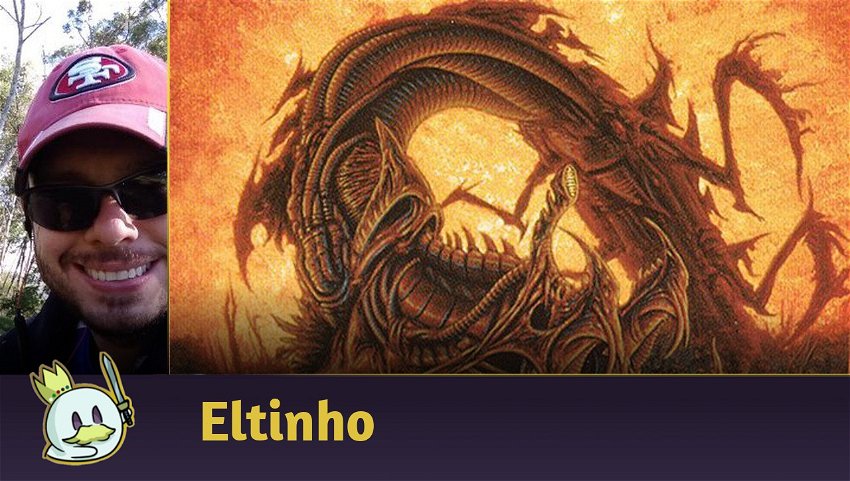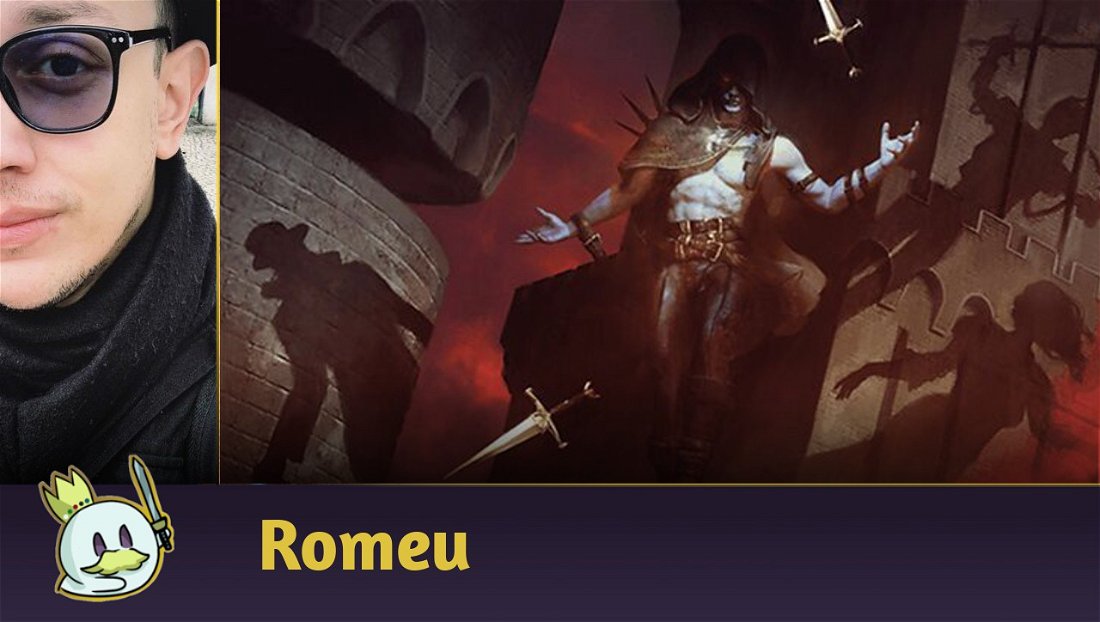Introduction
Good day, good afternoon, good night, everyone! Today, I hopped on a time machine; I'm speaking directly from October 1996, when not only "Mirage" had just been released, but also a young Eltinho (me) had just started playing Magic: The Gathering.
There I was in my innocent wonder years, building Goblin decks (which weren't as good as they are today), when I suddenly saw it: 1 mana, 12/12.
What?!
1 mana, 12/12. This can't be right. But it was. It was Phyrexian Dreadnought, in all its glory. I was stunned. It was a lot of stats for very little mana. And the artwork? Look at the size of that ridiculous wizard trying to cast a Fireball on this Phyrexian abomination! I fell in love with this card straight away.
Ad

As my knowledge of MTG deepened, I understood this card wasn't good and that its cost, 1 mana, was an illusion - so, playing this huge creature was a completely unrealistic plan. However, in Exodus, Pandemonium came out, a deck entirely dedicated to throwing Phyrexian Dreadnought's 12 power into the opponent's face. I could finally play, for real, one of my favorite cards!
... But then Wizards of the Coast decided to ruin everyone's fun and released a power level errata that made Dreadnought's ability a replacement effect instead of a triggered ability. Because of that, if you did not sacrifice creatures, it never hit the board and therefore didn't trigger Pandemonium.

The years went by, Wizards went back on this errata, and Dreadnought once again worked as a triggered ability - it also found one of its life-long best friends: Stifle. A happy ending! Or something like that. Stiflenought shows up every once in a while in Legacy (it is also one of the most powerful decks in the Premodern format), and is once again interesting nowadays because of some new cards and its positioning in the metagame.
Deckbuilding
This is a Combo-Control deck that has access to some common tools that Uro, Titan of Nature's Wrath decks, pre-Up the Beanstalk, have: Swords to Plowshares, Prismatic Ending, Brainstorm, Ponder, and Force of Will, besides Uro, Titan of Nature's Wrath itself.
Its combo part focuses on playing Phyrexian Dreadnought and ignoring its ability, which you'll be able to do with Stifle, Dress Down, or Doorkeeper Thrull. A 12/12 may not be a Marit Lage, but it finishes the game quite quickly too, besides being quite resistant to damage removals.
The greatest thing about its combo is that its non-Phyrexian half is quite useful on its own: Stifle countering activated abilities from fetch lands, if combined with Wasteland, can break your opponent's mana base, and all 3 are useful to protect you from a true combination of triggered abilities present in creatures that dominate Legacy nowadays.
Actually, the reason behind this deck's rising popularity has a lot to do with the fact that Doorkeeper Thrull is incredible against the Goblin deck. Think about it: if Torpor Orb has become a valid option in sideboards to stop both the Goblin threat and the dungeon activators in Boros Initiative, a deck that has this effect already in its main deck will probably conquer many victories in a format that has a massive presence of these archetypes.
To complete our list, Daze plays really well with mana denial effects.
Mulligan
Remember the combo deck mantra? "This is a combo deck, mulligan after your combo". Well, this isn't a combo deck in this sense, but rather a control deck that eventually steals some games with Dreadnought's incidental combo. So, it is completely acceptable to keep hands that can't play your 12/12 on turn 2 or 3, but that can interact with your opponent and eventually find a window to play this phyrexian threat, or even let Uro carry the game on its own. What matters is having interaction and ways to did through your deck.
Ad
Here are some examples of starting hands:

This hand has interaction, but it doesn't have ways to did thgrough the deck. It is acceptable if you know your opponent's deck, but, in a vacuum, it isn't ideal. Verdict: Mulligan against opponents you don't know, Keep only if you know you're facing a deck that is vulnerable to your countless counters.

Whoa, I mentioned before how you don't need to mulligan after a hand that plays your combo as fast as possible, but, now that it is here, okay, yeah? This hand has everything: Force of Will so we can protect ourselves, Stifle for fetch lands, Thrull if we need to stop triggers. Your opponent's deck is what will determine if you'll try to force a Stiflenought on 2, or if you'll play Doorkeeper Thrull to come back and play Dreadnought on 3. In any case, Verdict: Easy Keep.

This is a hand I mentioned before - it doesn't have our combo, but has interaction and Ponder to go after more. Verdict: Safe keep.

This hand is similar to the first hand we saw, but the difference is that it has answers (which aren't that expensive) for small threats, such as Dragon's Rage Channeler or Chalice of the Void, just like Force of Will. In any case, it is a bit risky if the matchup isn't the best to start with. Verdict: Risky keep, Mulligan if you know your opponent's deck ignores Prismatic Ending.
Building the Sideboard
As it is common in decks that have cantrips, this list uses many cards for similar purposes, but they can be more or less effective against different archetypes and decks. As graveyard answers, we have the eternal Surgical Extraction, with Silent Gravestone and Containment Priest, which is also useful against Show and Tell and Green Sun's Zenith.
Collector Ouphe is still a bomb against artifact decks. Lavinia, Azorius Renegade is quite useful against cards that tend to cost less than their original cost, also known as Up the Beanstalk's friends: our opponents aren't allowed to play Murktide Regent, Scion of Draco or Leyline Binding. It also stops the strategy of decks like Cascade Crash and Mississippi River.
Narset, Parter of Veils is an answer when card advantage matters - attrition games. We have Veil of Summer to deal with counters and discards, and Force of Negation to up how many turn 0 answers against life combos we have. And, finally, we have Hydroblast because it is one of the most efficient answers against anything that involves red.
Other sideboard options are Back to Basics, Brazen Borrower, Carpet of Flowers, Flusterstorm, Dismember, Hullbreacher, Stony Silence, and Subtlety.
Ad
Sideboard
Scaminator (UB Scam Hybrid)
Dress Down, Stifle, and Doorkeeper Thrull can prevent Atraxa, Grand Unifier and Grief's triggers from resolving, but they don't do anything against these creatures themselves: remember that an Evoked Grief with Dress Down or the Thrull on the board doesn't discard cards, but it also isn't sacrificed! This is why, in this match, your 12/12s will make a difference, as they can match up to their creatures and aren't easily removed.
Force of Will loses value against a deck that wants to empty its hand, and Prismatic Ending doesn't have many targets; this is why they come out after game 1.
In:

Out:

Grixis / Temur / 4C Delver
This is one of the matches in which Dreadnought makes a difference compared to standard control lists, as they have just a few answers for our 12/12 - Molten Collapse or Brazen Borrower, usually. As both decks hurt each other's mana bases, Daze becomes an incredibly efficient counter.
Out of all our combo cards, Thrull is the weakest here and can be hit with a Lightning Bolt with Dreadnought on the stack - that's why one copy of them will come out post-side.
In:

Out:

Goblin Stompy
Stiflenought's rise is directly related to Goblin's popularity, considering it is as if it already had a pre-sideboard against them, with all these answers to triggered abilities. Usually, they can play around counters with Cavern of Souls, and Simian Spirit Guide likes to show up out of nowhere to pay for Daze's additional mana - that's why they come out.
Force of Will is still useful to prevent them from destroying your game plan with a Chalice of the Void for 1. A play that tends to happen is them being forced to use the mana from the cavern to play _____ Goblin, and use its additional mana to play Muxus, Goblin Grandee, which won't be protected against counters.
In:

Out:

Beanstalk Control
As for this deck, it tends to be a challenging opponent because they're a more efficient Control deck, and they have answers for our 12/12. Narset post-side helps us stop Up the Beanstalk from getting out of control.
In:

Out:

Boros Initiative
On one side, you have countless ways to prevent their dungeon activators from taking the Initiative, even if they're protected by Cavern of Souls. On another, contrary to other aggro decks, they can remove Dreadnought - even though most of these removals can be stopped by the second half of your combo: Solitude is still a triggered ability, despite everything.
Ad
Collector Ouphe and Wasteland should give them lots of headaches in matches post-sideboards.
In:

Out:

Final Words
In case it isn't clear yet, I like Phyrexian Dreadnought so much that I have been carrying one in my wallet for more than 20 years! Maybe one day I'll tattoo it. I'm thrilled to see it is a part of the meta again!
See you next time!










— Comentarios0
Se el primero en comentar